9 Best Place to Visit in Doi Mae Salong (2025)
Mae Salong (Santikhiri) is a picturesque mountain village nestled in the far north of Thailand, in Chiang Rai Province. Perched at about 1,200–1,400 meters above sea level on the ridge of Doi Mae Salong, it rewards visitors with cool, misty weather and panoramic views of rolling green hills.
Once an isolated settlement of exiled Chinese soldiers, Mae Salong today is a tranquil community renowned for its lush tea plantations, hill tribe cultures, and seasonal cherry blossoms. Time seems to slow down here – in the mornings, the mountain slopes are often cloaked in fog, and as the sun rises, rows of oolong tea bushes emerge from the haze. The village, officially named Santikhiri (meaning “Peaceful Hill”), retains a unique cultural flavor: a blend of Yunnan Chinese traditions and Thai highland life. This guide will walk you through Mae Salong’s must-see attractions, unique experiences, the scenic route from Chiang Mai, and practical tips to make the most of your visit to this northern gem.
Location: Mae Fa Luang District (Thai: แม่ฟ้าหลวง, mâe fáa lŭuang), Chiang Rai (Thai: เชียงราย, chiiang-raai)
Population: 13,236 people (5,187 households)
Latitude: 99.626819
Longitude: 20.165701
Altitude: 1,367 m (4,485 ft)
GPS: 20°09’56.5″N 99°37’36.6″E
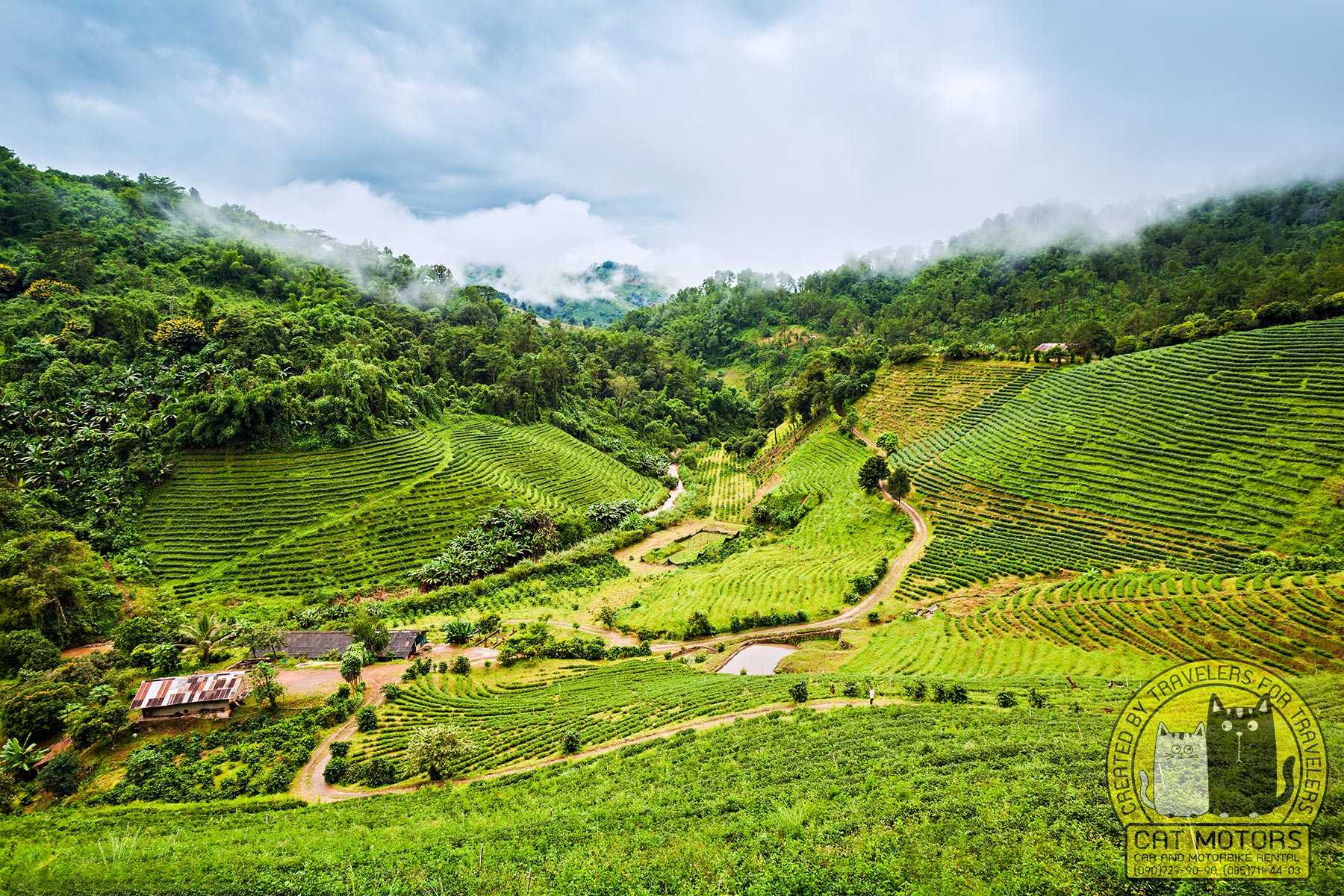
History of Doi Mae Salong
It is a community founded by former Chinese soldiers of the 93rd Military Division, affiliated with the Kuomintang under General Chiang Kai-shek. They were active in combat in the southern China region during World War 2.

Later, as China underwent radical political change, the Chinese Communist Party (CCP) under Mao Zedong successfully staged a coup and forced the Kuomintang to retreat to Taiwan. The 93rd Division was repeatedly attacked by pursuing CCP troops, forcing the soldiers to retreat into Myanmar (then known as Burma). But numerous clashes with the Burmese army resulted in the remnants of the 93rd Division being pushed back to Doi Tung and Mae Sai on the Thailand-Burma border.
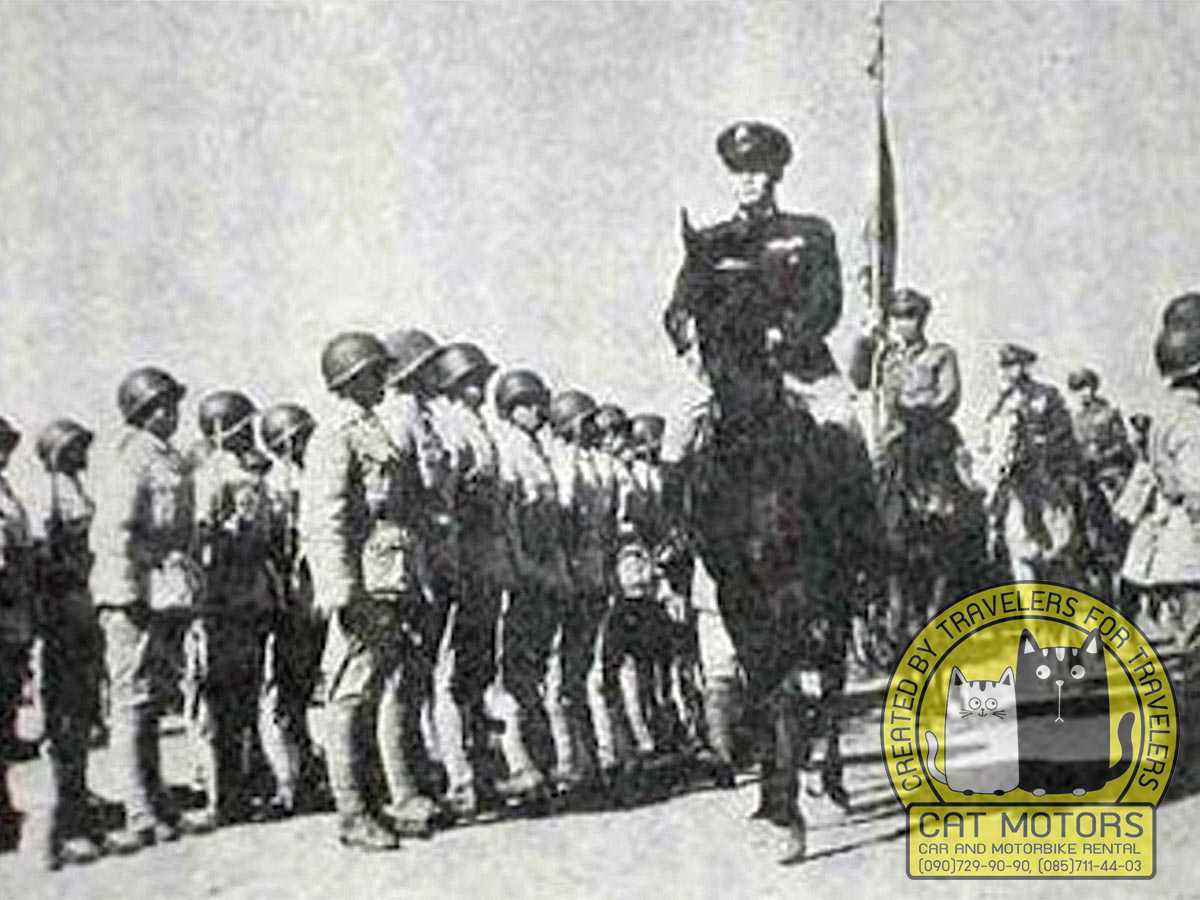
Burma filed a complaint to the United Nations in 1953. The UN resolved to evacuate the abandoned division to Taiwan, but 30,000 soldiers under the command of General Li Wenfan and General Tuan Shiwen requested asylum in Thailand, as they were not sure about the future of Taiwan, which is just a small island. The Thai government permitted the asylum and assigned General Li Wenfan’s men to settle at Tham Ngob, Fang District, Chiang Mai.
In contrast, 15,000 men under General Tuan Shiwen’s command settled at Doi Mae Salong in 1961. This also employed General Tuan’s men to be a buffer against ethnic minorities, which resulted in Doi Mae Salong gaining infamy as a mysterious, forbidden land with drug problems and armed militants during this era. The Thai government tried to alleviate the local problems by transferring these soldiers to serve under the Supreme Command Headquarters.
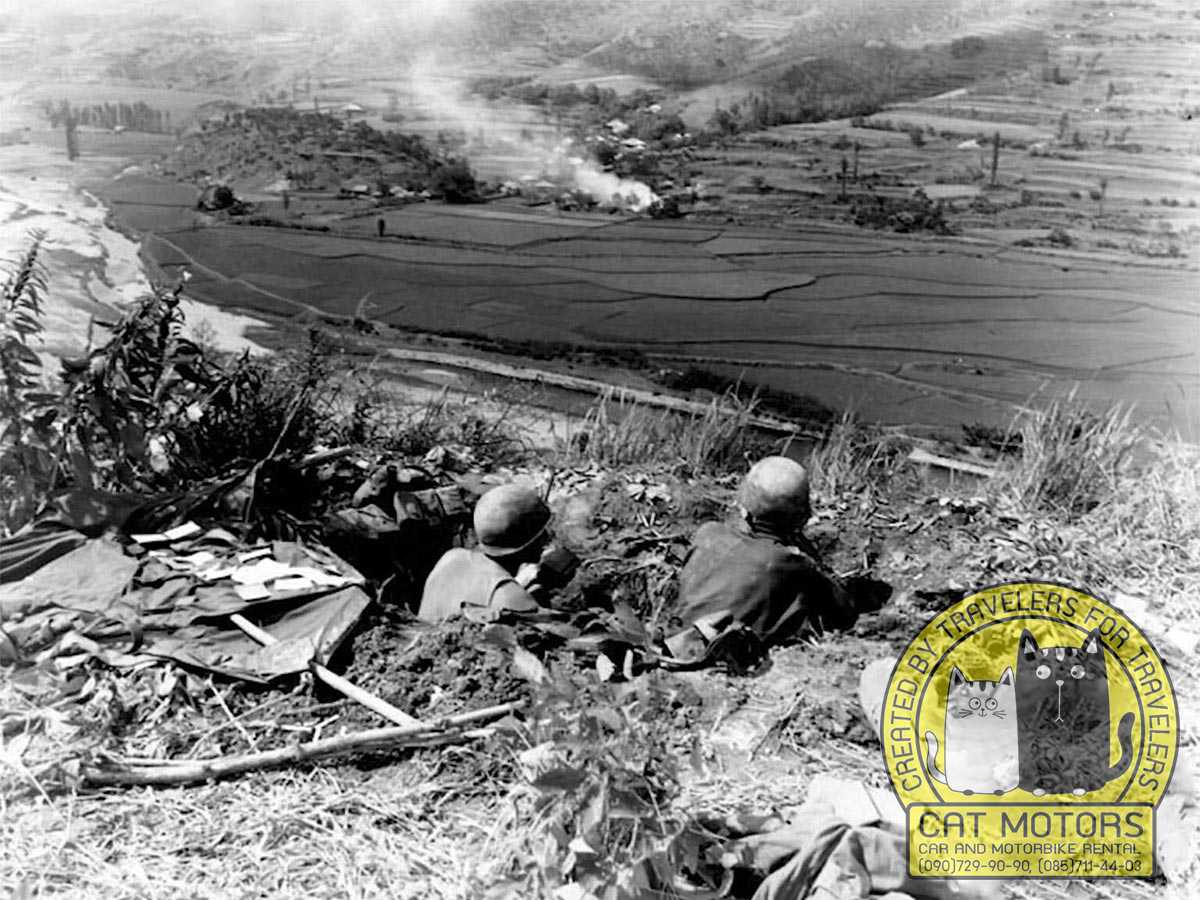
Eventually, in 1972, the Thai Council of Ministers resolved to officially accept the National Army soldiers to live in Thailand, leading to the end of the opium trade, disarmament, and adaptation to the agricultural way of life by the soldiers. In addition, former Prime Minister of Thailand, General Kriangsak Chamanan, commissioned a project to teach the soldiers how to grow tea and three-needled pines to replenish the local trees on Doi Mae Salong.
The Chinese community there was also renamed Santikhiri Village, and the Chinese citizens were issued Thai ID cards in 1978, finally returning peace to Doi Mae Salong. The location is now a popular tourist attraction ever since.
Getting to Mae Salong (Route from Chiang Mai)
Mae Salong is located about 250 km north of Chiang Mai (in Chiang Rai’s Mae Fa Luang District) and roughly 80 km northwest of Chiang Rai city. Despite its remote location, the journey itself is part of the adventure, especially for those traveling by motorcycle or car through the highlands of northern Thailand.
By Personal Vehicle (Car or Motorcycle): Driving from Chiang Mai to Mae Salong takes around 4.5 to 5.5 hours, depending on stops. The most common route is to head north via Route 107 through Fang and Thaton, then east toward Mae Salong:
- Chiang Mai to Fang/Tha Ton: The first leg brings you through rural valleys to the town of Tha Ton, near the Myanmar border. Consider a stop at Wat Tha Ton, a mountainside temple known for its giant Buddha statue and sweeping Kok River views. The roads are well-paved to this point, making for a comfortable ride.
- Tha Ton to Mae Salong: From Tha Ton, a smaller road (Route 1234) winds up into the mountains toward Mae Salong. This stretch is steep and full of hairpin bends – drive cautiously and enjoy the scenery. En route, you’ll pass hill tribe villages and may notice the air getting cooler as you gain elevation. A worthwhile detour (if you have time and your own transport) is the Fang Hot Springs (south of Tha Ton in Doi Pha Hom Pok National Park) for a quick natural hot bath, or a visit to an orchid farm along the highway.
- Alternate via Chiang Rai: Alternatively, if you’re coming from or via Chiang Rai city, drive north to Mae Chan on Route 1, then west toward Mae Salong (Route 1089 then 1234). On this route, a popular stop is the Choui Fong Tea Plantation near Mae Chan, where you can enjoy a cup of tea with views of neatly trimmed tea terraces – a nice prelude to the tea country of Mae Salong. The road up from Mae Chan is steep but paved. Keep an eye out for viewpoints; one notable spot has a panoramic lookout over the valleys and a sign welcoming you to Doi Mae Salong.
Driving yourself allows flexibility to stop for photos – expect verdant hills, occasional roadside stands selling local fruits or tea, and possibly encounters with livestock on the road in rural areas. Tip: If you are not accustomed to driving on mountain roads, take it slow and use low gear on descents. In the cooler months, morning fog can reduce visibility, so use headlights and caution.
By Public Transportation: Reaching Mae Salong by public transport is possible, though it requires a couple of transfers:
- From Chiang Mai, take a Green Bus or local bus to Tha Ton (approx. 4 hours). Buses leave from Chiang Mai’s Chang Phueak Terminal and cost around 150–200 THB. In Tha Ton, you will need to hire a local songthaew (shared pickup truck taxi) or private taxi for the final 40 km up to Mae Salong. Songthaews (if available) are the budget option (~60 THB per person) but run infrequently, so you might end up waiting. A private taxi from Tha Ton to Mae Salong costs around 600 THB. Alternatively, travel to Chiang Rai city first (3 hour bus from Chiang Mai), then take a local bus from Chiang Rai to Mae Salong (via Mae Chan) – these small buses or songthaews run a few times a day from Chiang Rai Bus Terminal 1, costing about 60 THB and taking 1.5–2 hours to climb up to Santikhiri.
- From Chiang Rai: If you’re already in Chiang Rai, head to the central market’s bus station (Terminal 1). Look for the songthaews or minibuses marked for Doi Mae Salong or Santikhiri. The journey (via Mae Chan) takes about 2 hours. Do note the departures are limited (often 2–4 times a day, e.g., morning and around midday). It’s wise to go early to catch a ride. The fare (~60 THB) is very inexpensive. You will be dropped off in the heart of Mae Salong (usually at the market square).
Travel Note: Public transport schedules may change, and services have been somewhat irregular in recent times as tourism recovers – it’s a good idea to check with locals in Chiang Rai or Chiang Mai for the latest timings. Once in Mae Salong, getting around the village and nearby attractions will require walking, hiring a local guide/vehicle, or renting a motorbike (if you arrived without one).
Things To Do In Mae Salong
Phra Borommathat Chedi Srinagarindra (Wat Santikhiri Temple)
Dominating the highest peak of Doi Mae Salong is the elegant Phra Borommathat Chedi, often simply called Wat Santikhiri. Completed in 1996 and dedicated to the late Princess Mother (HRH Srinagarindra), this Thai-style stupa stands about 30 meters tall on a mountain summit (approximately 1,500 m elevation).
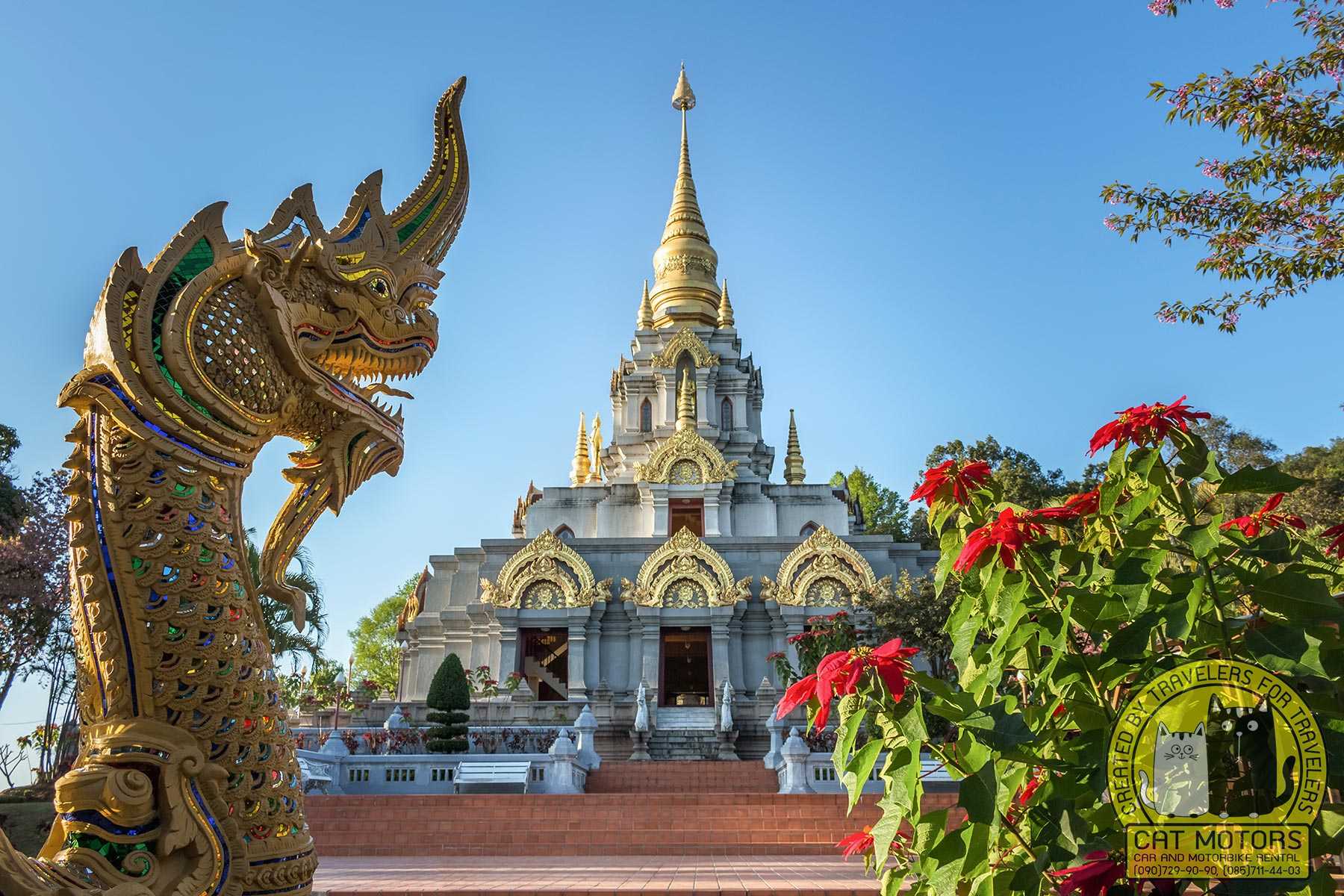
The chedi’s design is distinctive – an applied Lanna (northern Thai) style on a square base, with four archways and a gilded bell-shaped top. Clad in grayish-white tiles and accented with golden details, it gleams especially under the morning sun. Inside the pagoda, you’ll find venerated Buddha images and walls adorned with paintings. What makes the journey up here truly rewarding, however, is the 360° view: a sweeping panorama of misty mountains, the patchwork of tea plantations, and Santikhiri village far below. It’s an ideal spot for photography – many visitors come in the late afternoon to catch the soft light on the hills or in the evening for sunset. A steep but paved road leads to the chedi (about 4 km from the village); you can drive or hike up if feeling energetic. There’s no entry fee, but do dress modestly as it is a religious site. On clear days, you might see as far as Myanmar’s hills to the north. This serene temple symbolizes the peace that Mae Salong found after decades of turbulence – a place once strategic for soldiers is now meant for contemplation.
Google Map https://goo.gl/maps/6dufte3orgB6Yi9h8
Tomb of General Tuan (Silence of Peace Memorial)
General Tuan Shi-wen was one of the key KMT leaders who led his soldiers to Mae Salong. His tomb lies on a quiet hill about 1 km north of the main village (a turn-off near Khum Nai Phol Resort). The site itself is simple yet poignant: a white marble tomb housed under a pavilion with upturned eaves, blending Thai and Chinese architectural motifs. Built in 1980, this tomb honors General Tuan’s role in establishing Santikhiri; he died in 1980 on this very mountain he helped settle.

Visiting the tomb offers another panoramic view – from here you gaze directly down onto Santikhiri, with its neatly terraced farms and rooftops. It’s especially beautiful in the early morning, when the valley is often wreathed in fog. Two small tea shops have been set up nearby, so you can sip hot tea while reflecting on the extraordinary journey that led a Chinese general to be laid to rest in a Thai hill village. The path to the tomb is a bit steep (you can walk or drive a rugged road). There is no fee, but as it’s a revered site, maintain a respectful demeanor. For many locals of Chinese descent here, General Tuan’s tomb is both a monument and a shrine – during the Qing Ming festival (Tomb-Sweeping Day) or New Year, they come to pay respects, lighting incense and offering food.
Google Map https://goo.gl/maps/Z8UZPPqMwD4nJVbW8
Martyrs’ Memorial Hall (Chinese Martyrs’ Memorial Museum)
One of Mae Salong’s most important cultural sites is the Martyrs’ Memorial Hall, a museum that commemorates the community’s unusual heritage. In the mid-20th century, thousands of anti-Communist soldiers from China’s 93rd Division took refuge in Mae Salong after the Chinese Civil War. Many joined Thai forces to help resist Communist insurgents in the region during the 1960s–1970s. This museum, built with a traditional Chinese shrine architecture, honors those soldiers. Inside the red-and-gold building, you can explore exhibits of historical photographs, documents, and maps that recount the journey of the Kuomintang (KMT) soldiers from Yunnan to Myanmar to Thailand. The names of fallen soldiers are inscribed on wooden panels – a sobering memorial and a fascinating history lesson. You’ll also find old uniforms, rifles, and personal effects on display, painting a picture of the hardships and eventual assimilation of the Chinese soldiers in Thai society.
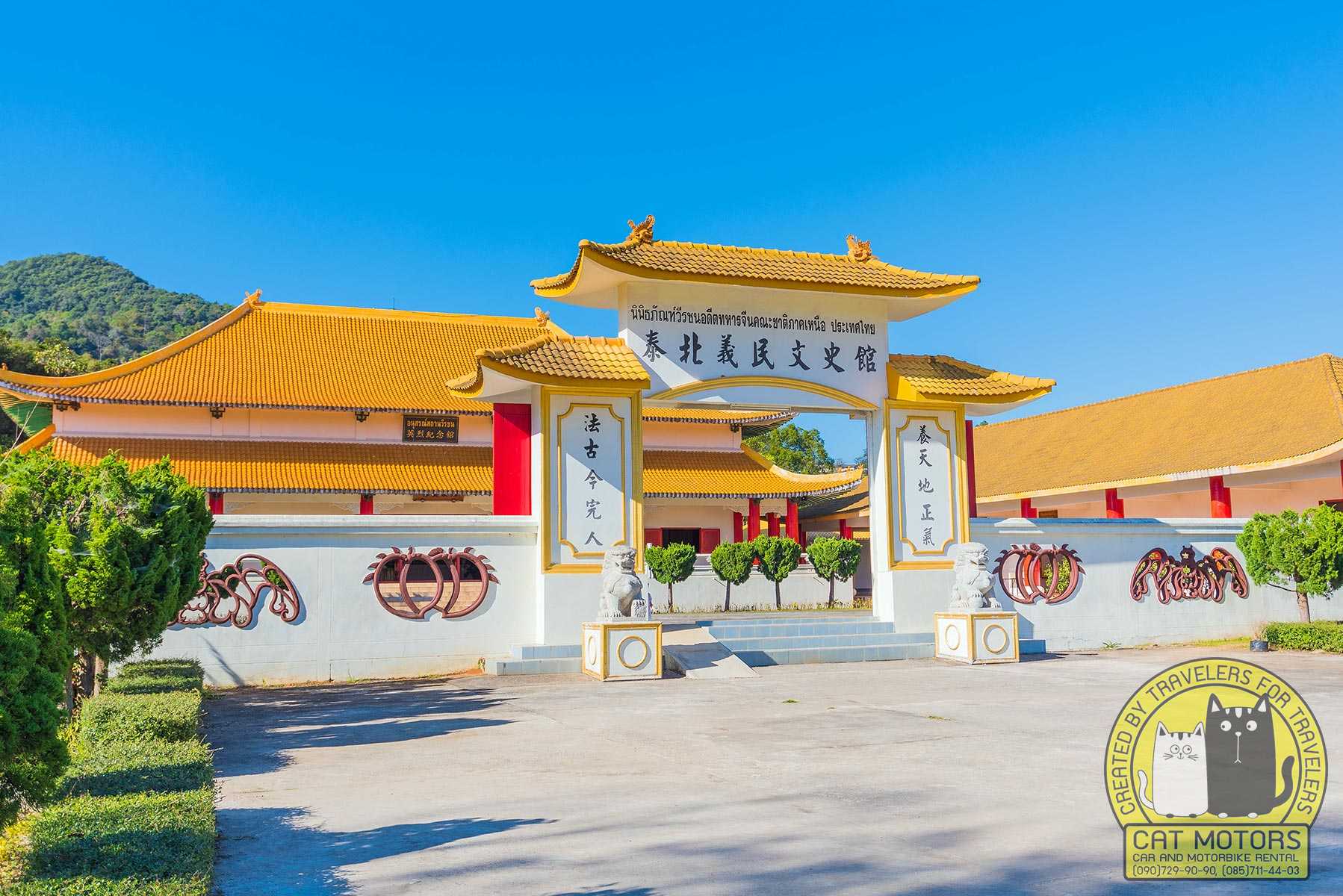
A large stone monument outside is dedicated to their contribution in fighting alongside the Thai army. The museum is located in the Santikhiri village center (easy to find by the Chinese-style gateway). There’s a small entrance fee (about 30 THB). Even if you’re not a history buff, the Memorial Hall is worth a visit to understand Mae Salong’s nickname: “Little Switzerland” – not for its geography, but as a peaceful haven forged after conflict. The museum’s courtyard also offers a nice view of the surrounding hills, and often you’ll find a local elderly resident willing to share personal stories (perhaps a descendant of those soldiers).
The first building tells the story of the struggles of the Chinese National Army soldiers in chronological order as follows:
– The historical background of the 1949 Chinese National Army (Lu Han, governor of Yunnan, revolted on December 8th, 1949)
– The Battle of Mong Ko, Tachilek (1950)
– The Battle of Mong Sard and the Attack on Yunnan (1951)
– The Battle at Salween River and the First Withdrawal to Taiwan (1951)
– Regroup at Chiang-La and the Second Withdrawal to Taiwan (1960-1962)
– The Battles in Northern Thailand
The exhibition displayed in chronological order each important event in which the Chinese National Army is involved, based on the date and time of each battle. Most of the exhibits display photographs of the battlefields and events and miniature models of the battlefields showing army movements and battle locations. However, there are only a few pieces of military equipment on display.
Additionally, there are no testimonial records of those who lived through these events documented or studied, which is unfortunate as there are not many people who have lived through these events still alive at present.
The central building is a memorial building. It is where the “spirit signs” of those who perished in the events are lined along the inner walls of the building, and there is a memorial ceremony dedicated to the fallen every year. Additionally, the exhibition displayed in Museum Room 2 presents the various contributions by the Chinese Association to Support Victims under the idea of “Love of Motherland and the Benevolence of Taiwan”. Such gifts are in the form of items or scholarships.
Google Map https://goo.gl/maps/ppbAuHwT3dqfL18v7
Taste Oolong Tea and Admire Tea Plantations
Mae Salong is synonymous with tea. After opium poppies were eradicated in the 1970s, the Thai royal projects helped villagers switch to cultivating high mountain oolong tea – a move that transformed the local economy and landscape. Today, endless rows of tea bushes contour the slopes around Santikhiri, making it one of Thailand’s premier tea-growing regions. Visiting a tea plantation is a must-do experience here. There are several plantations open to visitors.
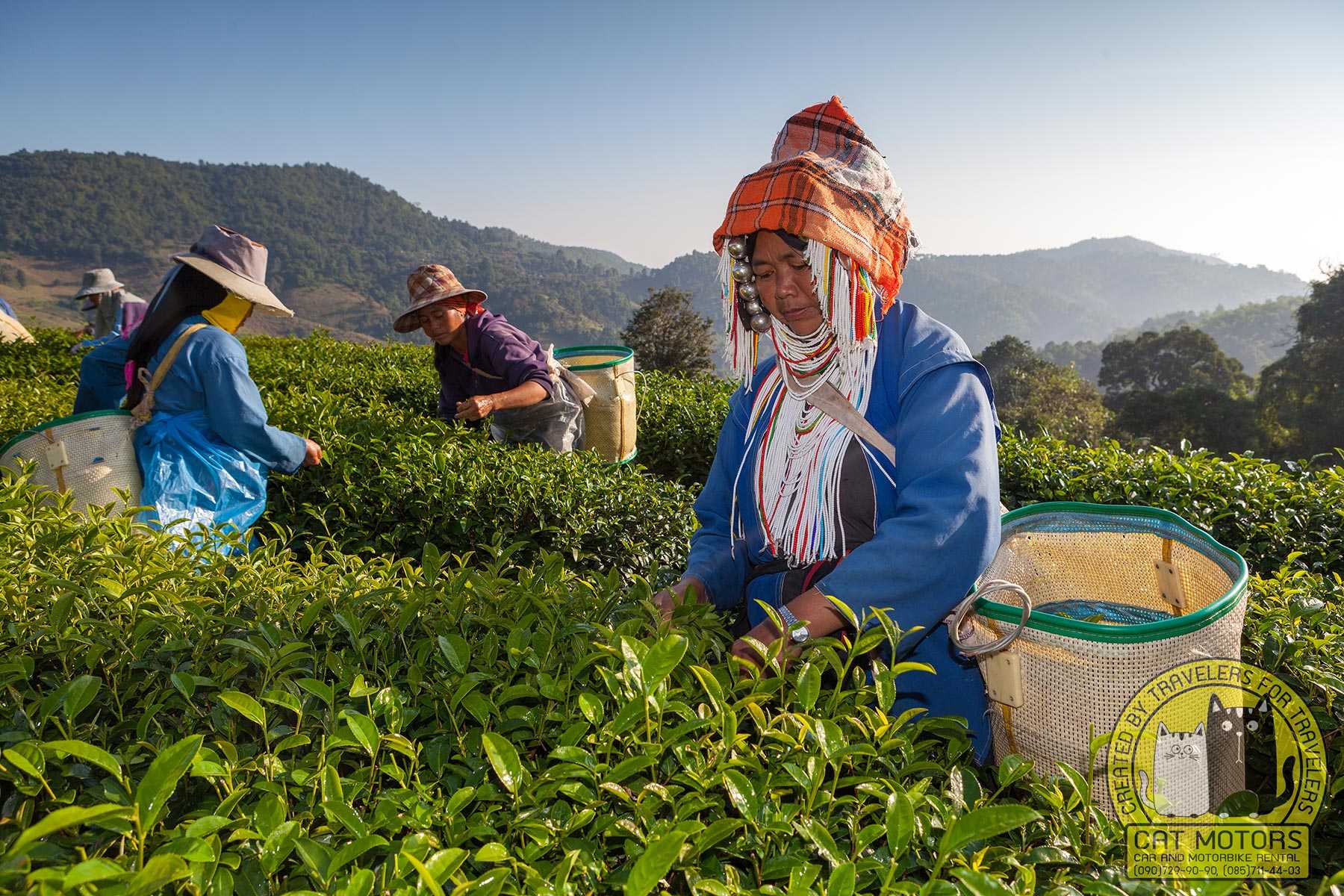
Rai Cha 101 (101 Tea Plantation)
Arguably the most famous estate, known for winning a “Best Tea” award internationally. As you arrive, you’ll see a sign and terraces of well-manicured tea plants. You can walk among the rows, often meeting hill tribe women in traditional clothes harvesting tea by hand. The farm offers tea tasting sessions – try their Oolong No.12 and No.17, which are local specialties with a floral aroma and smooth taste.
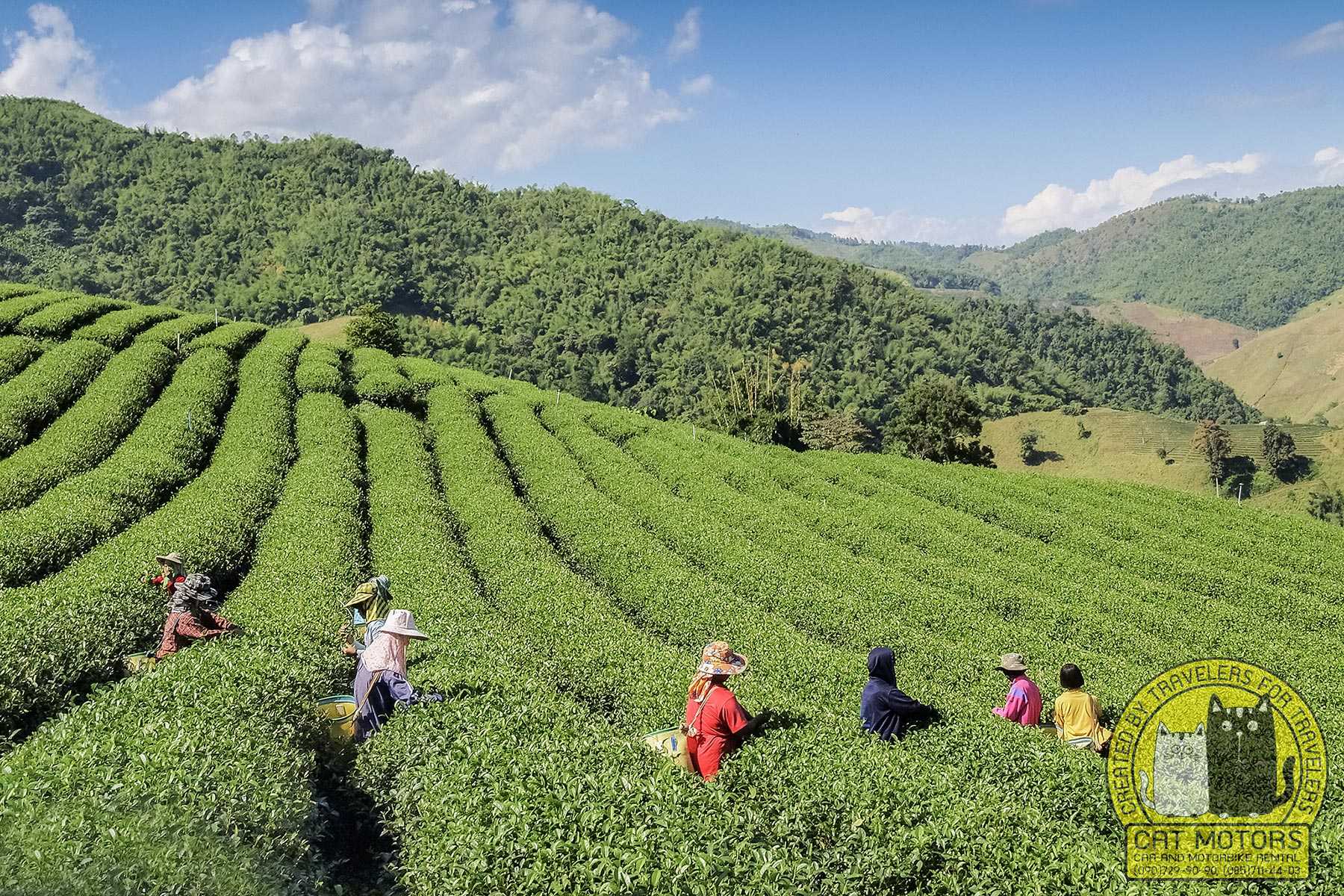
Staff will demonstrate the art of brewing oolong the Chinese way (short steeps in a gaiwan or small pot). It’s a sensory experience: inhale the nutty-sweet scent before sipping. There’s a shop where you can buy packets of tea straight from the source – a perfect souvenir.
Wang Put Tan Tea Plantation
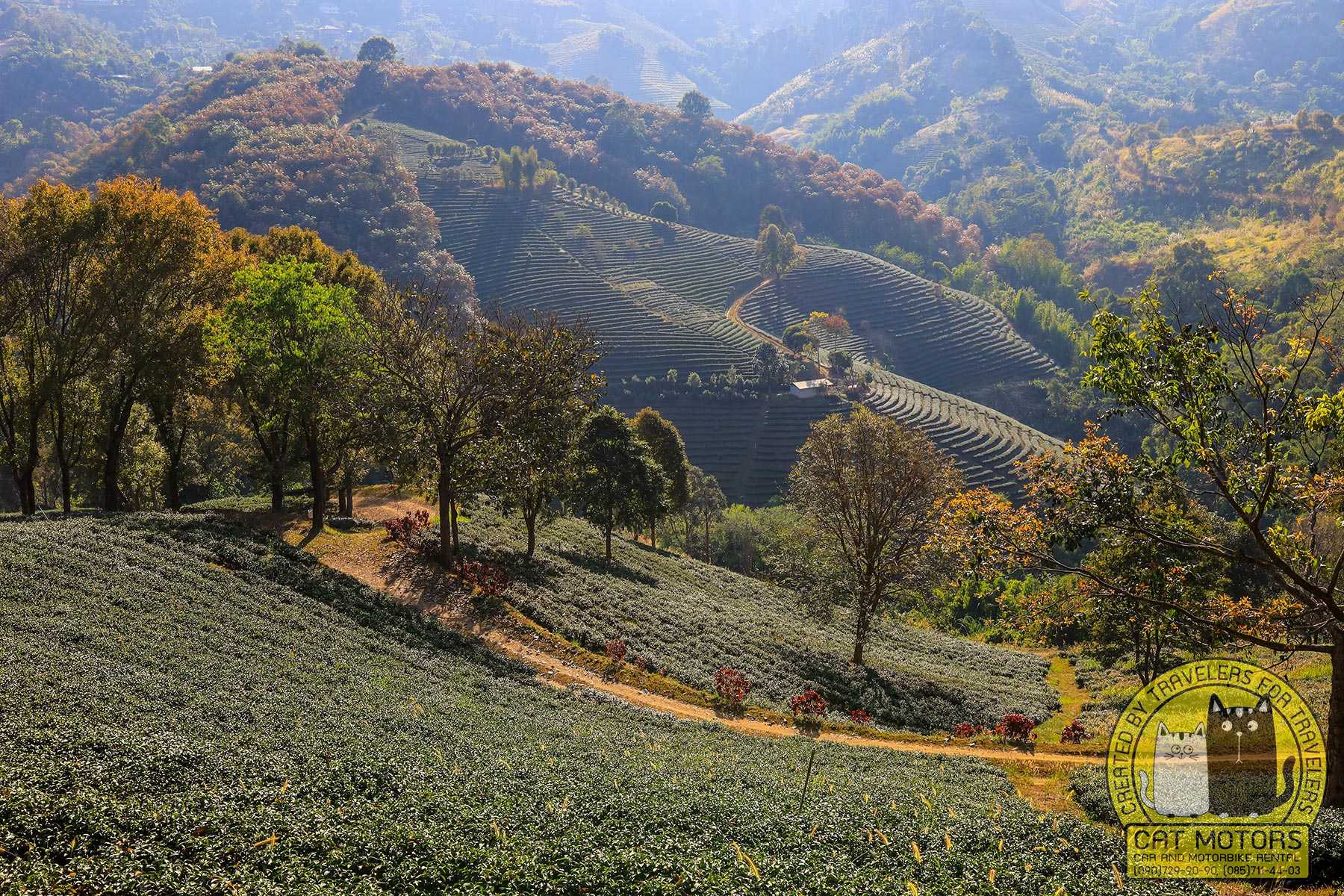
Another large plantation, Wang Put Tan is known for its grand display at the entrance – three giant teapot sculptures and two majestic lion statues guarding the gate. The plantation slopes are photogenic; platforms are set up for visitors to take panoramic shots with tea fields in the foreground.

They also have a café overlooking the plantation, serving tea-infused snacks and drinks (their green tea ice cream is refreshing on a warm day). Wang Put Tan has an adjacent Yunnanese restaurant (of the same name), so you can combine tea tasting with a meal (more on the cuisine later).
Google Map https://goo.gl/maps/SSQZvc8G3DwNHXfG8
Local Tea Shops in the Village
You don’t even need to go far for a tea experience – Santikhiri’s main street is lined with family-run tea shops. Every shop invites you in for a free tasting. It’s a delightful routine to wander down the street and step into shops where smiling owners pour you tiny cups of amber oolong or green tea. They will proudly explain how to steep the tea correctly and often share the health benefits of drinking tea.
Tip: Even if you’re not a big tea drinker, try the Thai specialty – tea leaf salad if available (some places sell pickled tea leaves, an influence from neighboring Myanmar, which you can sample as a spicy salad called “Yam Chaa”).
Tea is not just a drink here; it’s a way of life. You’ll likely see baskets of freshly plucked tea leaves, and if you’re curious, you can join in a picking session – the farmers might hand you a basket and show you which leaves to pick (usually the bud and first two leaves). The best time for a tea tour is in the cooler morning or late afternoon. By immersing yourself in Mae Salong’s tea culture, you’ll appreciate how this “green gold” replaced the old opium trade and now connects the community to the wider world.
Sakura Trees and Cherry Blossom Viewing (Dec–Feb)
One of Mae Salong’s magical natural attractions happens in the winter months: the blooming of wild Himalayan cherry blossoms. From late December through January (sometimes into early February, depending on the weather), cherry blossom trees (Prunus cerasoides) lining the roads and hillsides burst into pink bloom. These are often called “Thai sakura” by locals. If you visit around New Year, you’ll be greeted by tunnels of delicate pink flowers along the approach roads to Santikhiri.
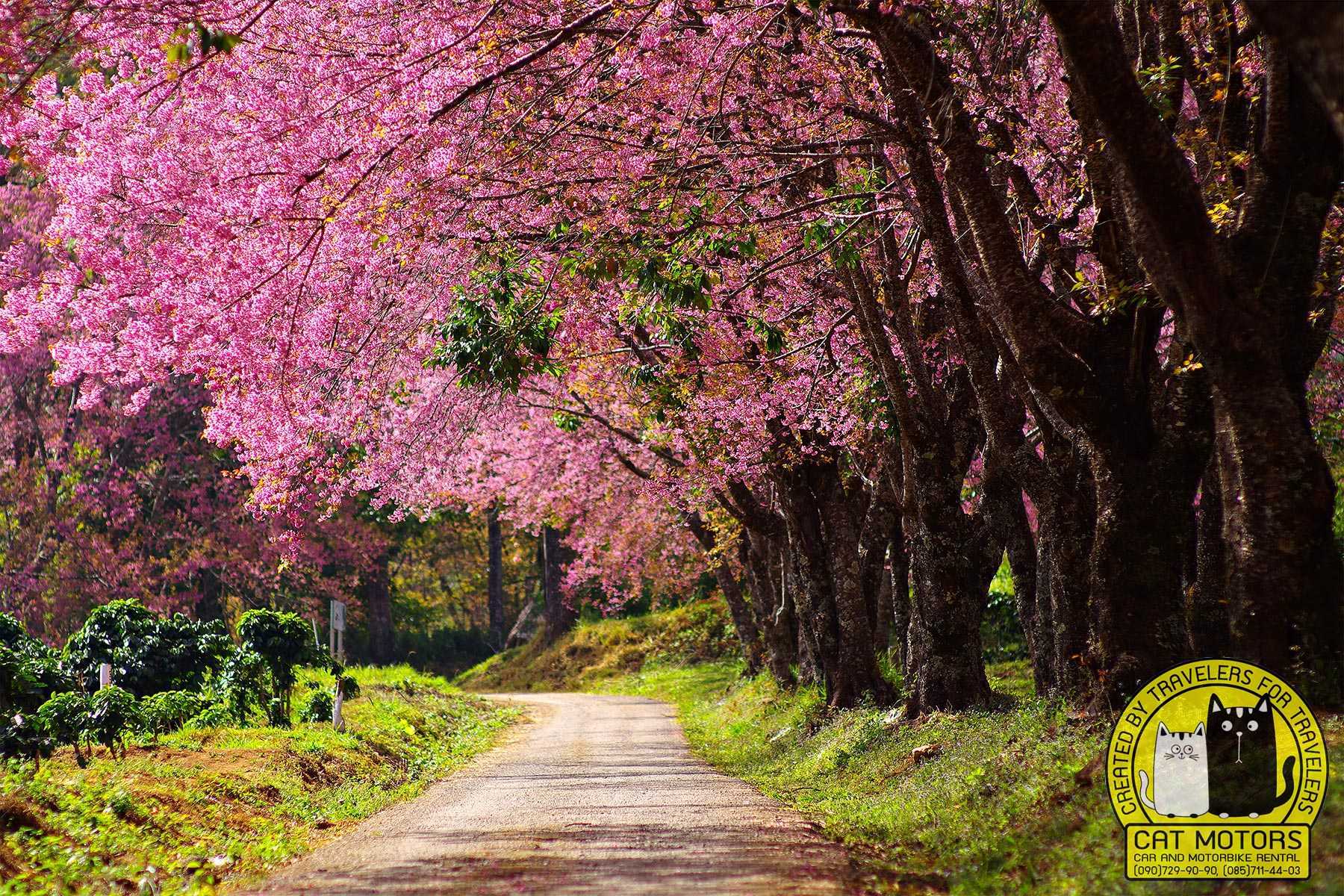
A prime spot is the road from Ban Khum up to Mae Salong, where cherry trees form a canopy for several kilometers. There is even a Cherry Blossom Festival (usually between 28 Dec and 2 Jan) hosted in the village, featuring cultural performances by hill tribe groups, music, and stalls selling local foods and handicrafts. Travelers and Thai tourists flock here for photos – imagine bright traditional tribal costumes dancing under falling pink petals. It’s an ethereal sight, and a reminder that Mae Salong’s climate is cool enough to nurture flowers more typical of Japan or Korea. If you’re keen to catch the blossoms, plan your trip accordingly (and book accommodation in advance, as it’s peak season). Do note that mornings can be chilly (single-digit Celsius), so pack a jacket. The spectacle of pink sakura against blue skies and emerald tea fields is truly one of the most unique experiences in Thailand.
Santikhiri Market and Morning Bazaar
To feel the pulse of local life in Mae Salong, spend some time in the Santikhiri Market, especially in the early morning. The market square in the center of the village comes alive around 6:00 am when the morning bazaar opens. Hill tribe villagers (Akha, Lisu, Mien, etc.) from nearby areas, as well as Chinese-Thai residents, gather to trade their goods. You’ll find an array of produce: fresh highland vegetables, medicinal herbs, wild honey, and of course packets of tea and coffee. This is the best place to sample authentic Yunnanese breakfast items. Try a bowl of steaming Yunnan rice noodles topped with minced pork, tomatoes, and pickled greens – a hearty soup locally called “Mi sua”.
Another treat is hot soymilk with youtiao (Chinese fried crullers) – several stalls squeeze fresh soy milk and fry dough sticks on the spot. You might also encounter Akha women selling grilled sticky rice in bamboo or bags of roasted chestnuts. The market is not just about food; you can buy handwoven tribal textiles, traditional Akha silver jewelry, and hill tribe coffee. Bargaining is common for non-food items, but always done with a smile. Even if you’re not buying much, the cultural experience is rich: you’ll hear a mix of languages (Yunnanese Chinese, Thai, Akha), see monks on their alms rounds, and perhaps catch the scent of incense if it’s a Buddhist holy day. By 9:00 am the bustle quiets down. The day market then operates more like a typical rural market, but you can still find tea, dried fruits, and spices throughout the day. This market scene is a reminder that Mae Salong remains a living village, not just a tourist attraction – spending baht here supports the local community directly.
Scenic Viewpoints (Sunrise & Sunset)
Mae Salong’s topography affords many stunning vantage points. For early risers, driving or walking a short way out of the village toward the east can reward you with a glorious sunrise. One recommended spot is near the entrance arch to Santikhiri (the big gate with Chinese characters) – from there you look eastward over mist-laden valleys as the sun peeks over distant mountains, bathing the hills in golden light. Another option is to ascend a bit towards the Phra Borommathat Chedi before dawn; along that road, you can stop at a bend that overlooks the village from above, watching the lights of Santikhiri wink out as day breaks. Conversely, for sunset, head to the west-facing side of Doi Mae Salong. A popular “sunset point” is at a small pavilion just beyond the Tea 101 plantation on a hill. Locals might direct you if you ask for the “sunset viewpoint”.
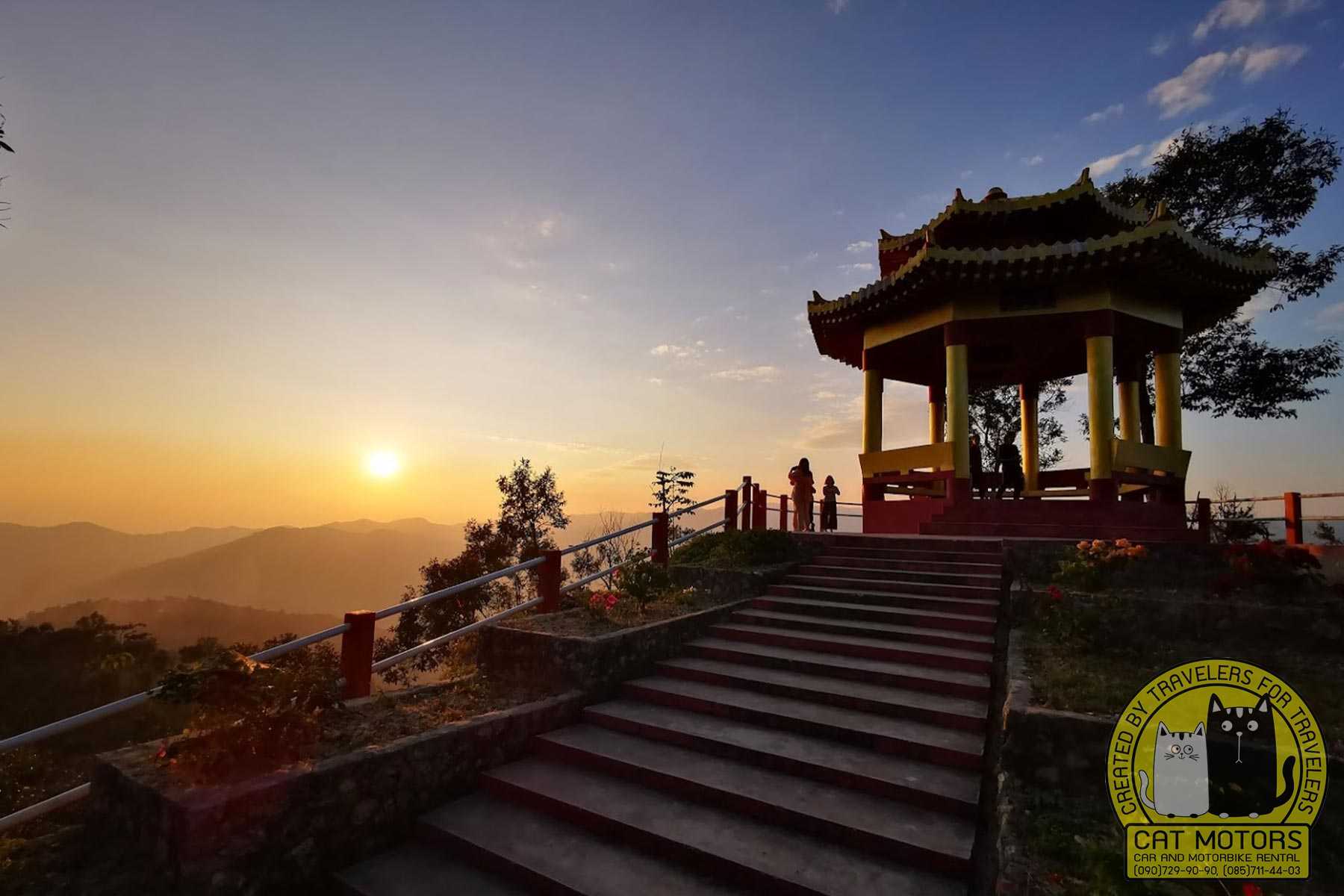
As the sun lowers, it paints the sky in hues of orange, pink, and purple, silhouetting the ridges of the Daen Lao Range. Often, a few travelers and villagers gather quietly to watch night fall over the tea fields – it’s a tranquil, almost contemplative atmosphere. Bring a light jacket as it gets cool after sunset. Some guesthouses also have rooftop terraces that serve as convenient viewpoints if you prefer not to venture out. In any case, dedicating time to simply admire the landscape at dawn or dusk will likely be one of your fondest memories of Mae Salong.
Google Map https://goo.gl/maps/8bGSd2ems8hCjuUg7
Unique Local Experiences
Beyond sightseeing, Mae Salong offers experiential activities that allow you to connect with its culture and environment on a deeper level:
- Stay in a Homestay or Tea Farm: Several local families open their homes to visitors for a homestay experience. Spending a night with a Yunnanese family can be eye-opening – you might help them pick vegetables for dinner, learn how they brew tea in the evening (a nightly family ritual), or even pick up some words of Yunnanese. Accommodations are basic but comfortable, often with thick blankets (necessary in the chilly nights). Waking up to the sound of roosters and stepping outside to see clouds drifting below the mountain is priceless. Some tea plantations like Wang Put Tan also offer simple lodges amid the tea fields, where you can sleep with the aroma of tea around you.
- Hill Tribe Village Visit: While Santikhiri is mainly ethnic Chinese, the surrounding mountains are home to various hill tribe communities. With a local guide, you can trek or drive to an Akha or Lisu village not far from Mae Salong. For instance, Akha people live in villages where you can observe their traditional stilt houses and perhaps watch women do intricate embroidery or beadwork on their tribal costumes. If you arrange in advance (through tour operators in Chiang Rai or guides in Mae Salong), you might experience a cultural show – Akha swing ceremony (if visiting in August/September) or traditional dances. Remember that these are genuine communities – be respectful, always ask before taking photos, and consider buying some handmade crafts to support them.
- Tea Processing Workshop: Another immersive activity gaining popularity is joining a tea processing workshop. Some plantations allow visitors during harvest season to follow the journey of tea from leaf to cup. You’ll start in the fields at dawn, plucking tea leaves alongside local pickers. Then, under guidance, you’ll wither, roll, and pan-fire the leaves using traditional methods. Over a day, you learn how green tea differs from oolong and black tea in processing. By the end, you can even take home a small batch of tea that you helped make yourself. This hands-on experience gives a newfound appreciation for the labor and skill involved in your cup of tea.
- Cooking Class – Yunnanese Cuisine: Given Mae Salong’s unique culinary heritage, a few enterprising locals have started offering cooking lessons. You might spend a morning shopping in the market for ingredients and then learn to cook dishes like Yunnan pork stew, stir-fried tea leaves with egg (yes, tea is used as a vegetable here), or jiaozi (Chinese dumplings) from scratch. One popular dish to learn is Khao Kha Moo (braised pork leg) done Yunnan style with spices and served with mantou buns – it’s simpler than it looks and delicious. Not only do you get to feast on your creations, but you can take the recipes home as a souvenir, extending the Mae Salong experience to your kitchen.
- Horseback Riding: Historically, the steep trails of Doi Mae Salong were navigated on horseback or mule. A couple of local outfitters keep horses and offer short horseback riding treks. It’s a nostalgic way to explore the area, trotting through tea plantations or to a nearby waterfall (such as Jinghawt Waterfall a few kilometers away). The horses are small mountain ponies, sure-footed on narrow paths. Even novices can usually participate (guides will lead the horse if needed). Imagine riding along ridges with a cool breeze, channeling the spirit of old caravans that once traversed these hills.
Each of these experiences lets you live Mae Salong rather than just see it. The village’s slogan could well be “slow down and steep in the atmosphere” – much like making a good cup of tea, taking your time here yields the richest flavor of memories.
Local Cuisine and Gastronomy
Mae Salong’s cuisine is a flavorful blend of Thai highland fare and Yunnanese Chinese influence – a direct result of its history. Eating in Santikhiri is one of the highlights of a visit, as many dishes and ingredients are unique to this area.
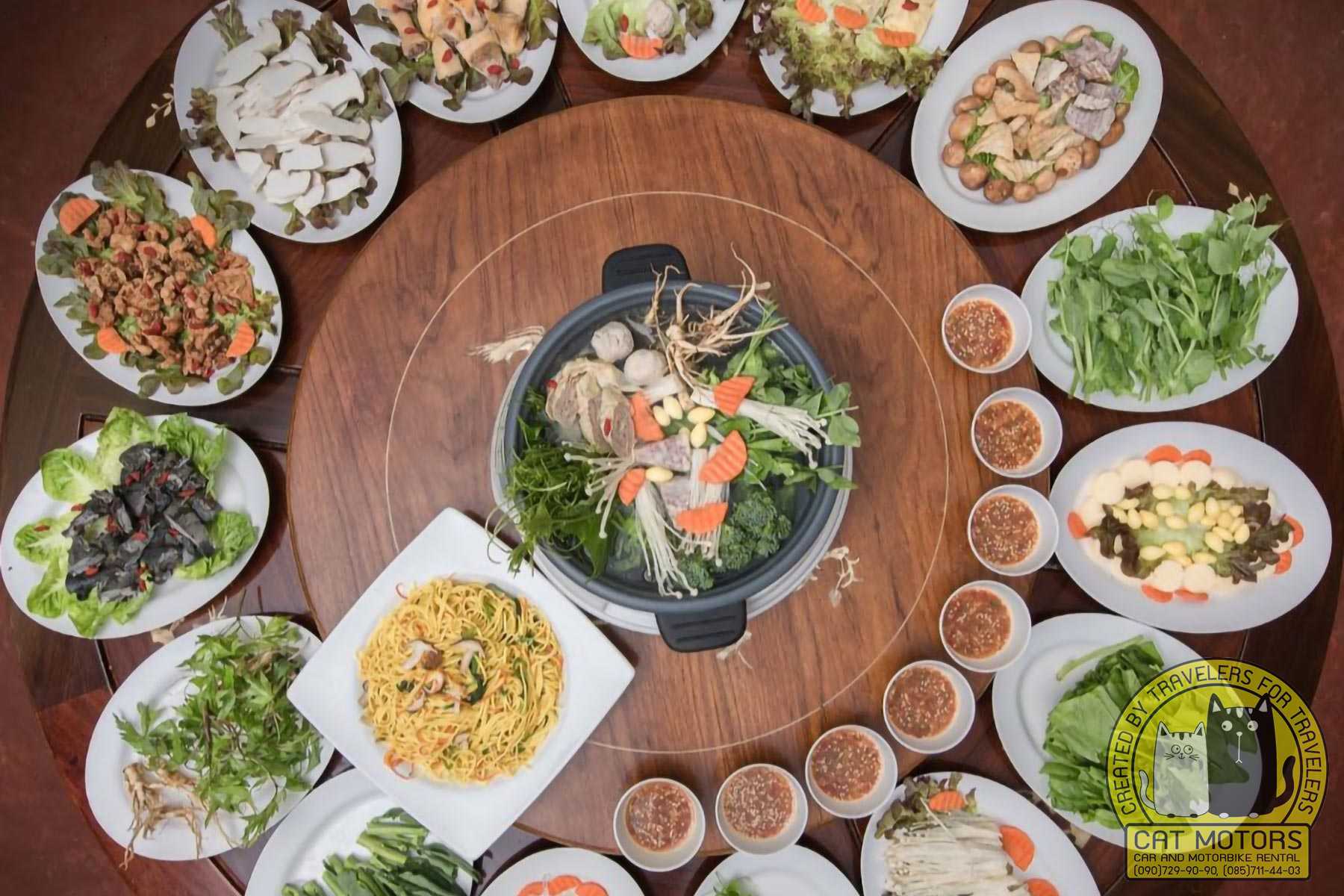
A bowl of Yunnanese kuai-tiao (noodle soup) in Mae Salong, topped with tender pork, tomato-based chili paste, and local greens – a delicious fusion of Chinese and Thai flavors.
Yunnanese Specialties: The descendants of the Chinese settlers have preserved various Yunnan recipes. One must-try dish is the Yunnan Pork Leg (Braised Pork Knuckle) – pork hock slowly simmered in a rich soy-based broth with star anise, garlic, and herbs until it’s melt-in-your-mouth tender, served with mantou (steamed wheat buns) to mop up the sauce. This dish is famously served at Im Pochana restaurant and a few others in the village, and is considered the taste of Mae Salong.
Another staple is Yunnan Noodle Soup, a hearty bowl featuring rice or wheat noodles in a light bone broth, topped with slices of pork, blanched greens, and a dollop of a unique chili-tomato relish that gives it a slightly tangy kick. It’s often eaten for breakfast – you’ll see tourists and locals alike sitting on low stools at the morning market blowing on hot noodles. Steam buns and dumplings are common here too – look for morning vendors selling piping hot baozi (steamed buns stuffed with pork or sweet red bean) and pot-sticker dumplings.
Thai & Tribal Influences: Being in Northern Thailand, Mae Salong also offers Shan and tribal dishes. You might encounter naem (fermented pork sausage) grilled on a stick, or abr – a spicy meat salad wrapped and cooked in banana leaf, a specialty of the Akha people. At the market or roadside stalls, try Khao Soi Mae Salong, a local twist on the famous northern curry noodle soup, sometimes made with Chinese noodles and local spices. For something light, sample the tea leaf salad mentioned earlier: young tea leaves that have been fermented are tossed with chili, lime, peanuts, and tomato – a tangy, slightly bitter salad originally from Myanmar, reflecting Mae Salong’s crossroads of cultures.
Tea and Drinks: It goes without saying that tea is the drink of choice. Order a pot of Oolong No.12 or No.17 with your meal – its fragrant, clean taste complements the often rich and spicy foods. You can also try Miang – not a drink but a snack: pickled tea leaves sometimes served with ginger and nuts, to be chewed as a digestive (an acquired taste, but truly local). If you’re visiting in the colder months, warm up with Yunnan hot pot available at some eateries – a bubbling broth in which you cook fresh veggies, meats, and mushrooms grown in the hills. For the brave, a glass of locally brewed corn whiskey or rice wine might be offered by hospitable hosts; these potent spirits are homemade by hill folk and definitely pack a punch.
Restaurants: Mae Salong has a handful of small restaurants, mostly family-run. Aside from Im Pochana (with its legendary pork leg), Wang Put Tan Restaurant offers an array of Yunnan dishes in a setting right next to tea fields. Shin Sane Guesthouse also has a restaurant known for mixing Thai and Chinese styles – you can get a curry as well as dumplings. Don’t expect anything fancy or western; the fare is authentically regional. Vegetarians will find options too, thanks to the abundance of local produce and tofu (just communicate your needs, as some broths are meat-based).
In Mae Salong, eating is not just about filling up – it’s a cultural exploration. Every meal tells a story of migration, adaptation, and coexistence of different peoples. Be adventurous and savor the experience: the spice of Sichuan peppercorns in a mountain stew, the sweetness of freshly picked passionfruit sold by the roadside, or the comfort of a bowl of noodles on a crisp morning. Your taste buds will remember Mae Salong as fondly as your eyes do its scenery.
Practical Tips for Travelers
- Climate and Best Time to Visit: Mae Salong enjoys a cooler climate than most of Thailand. Daytime temperatures are pleasant (15–25°C) for much of the year, while nights can drop to 10°C or below in December–January. The dry season (November to February) is the best time to visit – you’ll get clear skies, the cherry blossoms in Jan, and ideal conditions for hiking and photography. March and April start getting hazy (due to regional crop burning, views might be less crisp) and quite warm in the day. The monsoon (May–October) brings green landscapes and quiet streets, but also occasional landslides on mountain roads and rain that can disrupt travel plans. If visiting in winter, pack layers – a light jacket for evenings and early mornings is necessary. Also, the sun is strong at altitude, so sunscreen is recommended even if the air feels cool.
- Accommodation: Despite its small size, Mae Salong has a range of accommodations, from simple guesthouses to boutique resorts. Most are locally owned. If you want an immersive experience, opt for a guesthouse in the village – they are often wooden Thai-Chinese houses where rooms are basic but clean, with hot water and mosquito nets. Waking up to villagers chattering in Mandarin below your balcony is quite charming. For more comfort, Mae Salong Villa and Phumektawan Resort are on the outskirts, offering private bungalows with splendid valley views. They can arrange bonfires at night, which is lovely in the cold season. Prices are generally affordable (starting around 500 THB for budget homestays to 1500+ THB for nicer resorts). On weekends in high season or during festivals, it’s wise to book ahead as the limited rooms can fill up with Thai tourists.
- Getting Around Mae Salong: The village itself is small enough to explore on foot. The main road stretches about 1.5 km – you can stroll from one end to the other in 20–30 minutes, passing shops, cafes, and the market. To visit outlying attractions (the chedi, tomb, plantations), if you don’t have your own vehicle, you have a few options: hire a local songthaew/taxi (ask your guesthouse to arrange, they often have someone available for day hires), rent a motorbike in the village (availability can be limited, and bikes might be older – helmets are a must on the winding roads), or arrange a guided trek for nearby spots. Bicycles are another option for the fit – the uphills are challenging, but many enjoy cycling through the tea country in the cool air. Bear in mind, there is no gas station in Santikhiri; fuel is sold in bottles at small shops.
- Language and Communication: In Mae Salong you’ll hear a lot of Yunnanese Chinese spoken among the locals, and signs in Chinese, Thai, and sometimes English. Many older residents speak Mandarin (and Thai with an accent), while younger ones speak Thai as their primary language. English is limited but since the town is used to tourists, basic words are understood at guesthouses and main shops. Learning a few phrases of Thai (or Mandarin, if you’re up for it) will earn you warm smiles. Don’t be surprised if locals greet you with a hearty “Ni Hao” – they might assume you’re a Chinese visitor at first. A unique aspect: even the Thai spoken here has loanwords from Mandarin due to the community’s heritage.
- Money and Supplies: Bring sufficient cash before coming to Mae Salong. There is no bank or ATM in the village (the nearest ATM is in Mae Chan or Thaton, quite far away). Most transactions (food, lodging) are cash-only. Only a couple of larger resorts or shops might accept online transfers or credit cards, but it’s not common. For supplies, there are small convenience stores selling snacks, toiletries, and basic medicine, but it’s wise to carry any specialty items you need. In terms of medical facilities, there’s a local clinic, but anything serious would require a trip to Mae Chan or Chiang Rai hospital. It’s a good idea to have a small first aid kit with you.
- Etiquette and Cultural Respect: The way of life in Mae Salong is laid-back and traditional. When visiting temples like Wat Santikhiri or interacting with monks in the morning, dress modestly (shoulders and knees covered) and speak softly. If you enter the Chinese temple or shrine area at the Memorial Hall, you can observe locals lighting incense – you may do so as well (incense sticks are usually available for a small donation), just follow what the locals do. Always remove shoes when entering temple buildings or local homes. The people are friendly but a bit reserved; a smile and “Sawasdee” or “Ni Hao” go a long way. If taking photos of people (especially hill tribe villagers in their attire), ask permission – most will agree, some may shy away. Showing them the photo afterwards is a nice gesture and often breaks the ice.
- Connectivity: Mobile phone coverage in Mae Salong is decent for Thai carriers (AIS, True, DTAC all have signal in the village center, though it may drop in some hilly spots). 4G data works but can be slow at times. Many guesthouses offer free Wi-Fi, but don’t expect high speeds – enough for email and messaging, but sometimes not for heavy streaming. This is a destination where being slightly “off-grid” adds to its charm, so you might find yourself happily putting the phone away except for snapping photos.
- Environmental Consciousness: Mae Salong’s natural beauty is one of its assets. Help keep it that way – don’t litter (you’ll find bins in the market and main areas, but if hiking, carry your trash out). If you visit tea plantations or farms, stick to paths to avoid damaging crops. The region has been reforested significantly since the 1980s, so be mindful if you’re smoking or lighting any fires – the dry season is prone to forest fires. Also, use water sparingly, as hillside water supply can be limited in the dry months.
By keeping these practical tips in mind, your trip to Mae Salong will be smooth, respectful, and deeply rewarding. This mountaintop enclave offers a rare mix of natural splendor, cultural richness, and historical intrigue – all at a gentle, unhurried pace. Whether you came for the tea, the views, or the history, you’ll likely leave Mae Salong with a sense of peace and a hint of its fragrant oolong forever ingrained in your memory. Enjoy your journey to Thailand’s little Yunnan, and soak in every moment of this highland haven.
Weather
In our opinion and from our observations, the weather widget from Meteoblue shows the most accurate weather forecast in Doi Mae Salong most often. Therefore, we are posting this for you.
If you don’t know what sights you want to see in northern Thailand yet, check out our Things to do in Chiang Mai travel guide
Quick Facts About Doi Mae Salong
Location: Doi Mae Salong is located in the northern part of Chiang Rai Province, Thailand.
Altitude: It’s situated at an elevation of about 1,800 meters above sea level.
Cultural Heritage: Originally settled by Kuomintang soldiers from China in the mid-20th century, the area is known for its strong Chinese cultural influences.
Tea Plantations: The region is famous for its high-quality Oolong tea, which has become a significant part of its economy and cultural identity.
Climate: Doi Mae Salong enjoys a cooler climate, with misty mornings and relatively cool temperatures throughout the year, especially compared to other regions in Thailand.
Tourist Attractions:
- Santikhiri Village: The main settlement in Doi Mae Salong, known for its Chinese-style architecture and vibrant market.
- Tea Tasting and Plantation Tours: Visitors can tour tea plantations and participate in tea tasting sessions.
- Wat Santikhiri Temple: A prominent temple offering panoramic views of the surrounding hills.
History:
- Kuomintang Influence: After the Chinese Civil War, Kuomintang soldiers settled here and played a significant role in the area’s history and development.
- Opium Replacement: The region was once known for opium cultivation, which has been largely replaced by tea and other crops as part of royal development projects.
Ethnic Diversity: In addition to the predominant Yunnanese Chinese community, there are also several hill tribes in the surrounding areas, including Akha and Lisu people.
Cuisine: The area is known for its unique blend of Thai and Yunnanese Chinese cuisine.
Accommodation: Offers a range of accommodations, from simple guesthouses to more comfortable resorts.
Accessibility: Accessible by road, with winding and scenic routes. The nearest major city is Chiang Rai.
Festivals and Events: The Chinese New Year and the Cherry Blossom Festival are significant events celebrated with much fanfare.
Shopping: Known for local markets where visitors can buy tea, Chinese herbs, and local handicrafts.
Languages Spoken: Predominantly Yunnanese Chinese and Thai, with limited English in some areas.
Best Time to Visit: The best time is from November to February when the weather is cool and dry.
Natural Scenery: The region is characterized by rolling hills and lush green landscapes, ideal for nature lovers and photographers.
Conservation Efforts: There are initiatives to promote sustainable tourism and preserve the natural environment.
YT Video Review
Mark Wiens’ Day Trip
Mark Wiens from migrationology.com visited the place a long time ago, but he still remembers it with rapture and fondness.
A Day Trip with Len Rutledge
Traveler and writer Len Rutledge said a few words about Mae Salong and Doi Tung. Doi Tung is not far from here, so it makes sense to visit them both.
FAQ
The easiest way to get to Mae Salong from Chiang Mai is by public bus. The trip takes about 5-6 hours and costs about 150-200 baht. You can also book a private transfer, which will cost you about 5,000 baht. You can also rent a motorcycle from our rental shop. If you prefer to travel by car, then we recommend that you look at EconomyBookings or RentalCars, where you can find the best deals on car rentals in Chiang Mai.
Yes, Mae Salong is worth visiting. It is a beautiful mountainous area in northern Thailand that offers stunning views and plenty of outdoor activities. There are plenty of tea plantations, temples, and natural hot springs to explore, as well as local markets and restaurants. It is also a great place to experience the culture and history of the area.
Doi Mae Salong is located in Chiang Rai Province, northern Thailand. It sits at an elevation of 1,400 meters above sea level, making it one of the highest points in the region.
Near Doi Mae Salong, there are several attractions to explore. These include tea plantations, temples, natural hot springs, local markets, and restaurants. There are also several hiking trails in the area, as well as a number of waterfalls and other natural wonders.
Yes, you can visit this place even in compact cars with an engine of 1-1,2L. But in rainy weather, it is better to prefer a more powerful car or a car with a manual gearbox. Also, be sure to pay attention to the fact that some roads here are narrow and winding and require good driving skills.
As in any other mountain region, it is best to use motorcycles with a manual or semi-automatic gearbox; the low gear will help you to easy ascend the mountain and reduce the possibility of accidents when descending the hill.
If you rent a motorbike with an automatic gearbox, for one rider, you should choose a bike with an engine capacity of at least 125cc, and for the rider and passenger, you should choose a bike with an engine capacity of at least 150cc.
The rainy season typically runs from May to October, with temperatures dropping to a more comfortable range of 25°C (77°F). During this time, the area experiences heavy rains and cooler temperatures.
The hot season in Mae Salong typically runs from March to May, when temperatures can reach up to 40°C (104°F).
The smog season in Mae Salong typically lasts from late February to April. During this time, the air quality can be quite poor due to the burning of crop stubble in the area. It is best to avoid the area during this time if possible.
Mountain marigolds bloom in the area around November-December. The best time to see the cherry blossoms is from mid-December through mid-February.
The best time to visit Mae Salong is from October to February, when the weather is cool and dry. This is also the peak season for tourism in the area, so expect plenty of visitors. However, the area can be enjoyed year-round, with mild temperatures and plenty of activities to enjoy.
Experience the wonders of Northern Thailand by following our detailed travel guides, which map out picturesque routes and exciting local spots. To ensure a smooth start, visit our scooter rentals in Chiang Mai home page. Be sure to familiarize yourself with our terms & rates to make your trip hassle-free. With our guides, you’ll navigate the region’s picturesque roads and vibrant communities with ease and confidence. Explore everything from serene mountain paths to bustling town markets with our comprehensive travel resources.
Additionally, make sure to visit our tips and advice sections, where you’ll find essential recommendations for safe riding. Our website is packed with valuable information to help you make the most of your motorbike adventure. By utilizing these resources, you can ensure a well-planned, memorable trip that captures the true essence of Northern Thailand’s natural and cultural treasures.
Cat Motors Team
Was this post useful for you?
You can rate it by clicking on a star
Average rating / 5. Vote count:
No votes so far! Be the first to rate this post.
We are sorry that this post was not useful for you!
Let us improve this post!
Tell us how we can improve this post?
- Author: Krit Sorenser
- Updated: March 26, 2025
- 3 Comments





3 Comments
Took the bus from Chiang Mai to Tha Ton today (March 2023). Arrived at the bus terminal in Chiang Mai at 11:45am, the next bus was at 1:30pm. The bus to Thaton took 4+ hours. Arriving in Thaton at 5:30pm no songthaews or private taxis were available for the rest of the day, so we are spending the night in Tha Ton. The guesthouse owner helped us arrange a private car for 1000THB in the morning. What we were told is songthaews no longer run on any regular basis post covid and they can be very expensive. To do a shared songthaew you will need take one from the main taxi terminal and then transfer to another at the police station check point which may require waiting/hitch hiking. Hope this helps!
Hi, Laura! Thanks for your comment, we update it! We also want to give you some very useful advice! Next time, please, before you hire a private car, be sure to check the cost of the trip on apps like Grab or InDrive. For example, right now I’m looking at the Grab app, and it shows me that from Tha Ton Bridge (the furthest point in the town) to Mae Salong you can get a ride for only 520 baht.
I read the article and headed off before reading the comments. Fortunately I didn’t read Laura’s comment as it might’ve dissuaded me from taking the songthaew from Fang to Tha Ton. I ran into the same problem of no songthaew available and being told the only option was a private truck. Instead I hitchhiked to Mae Salong without problem, three cars with minimal waiting. I wouldn’t rule this out as an option for anyone looking to do the Mae Salong loop via transit.